Thanks to bike trainers, the indoor training season is more bearable and you can get stronger. Smart bike trainers and their training apps give you a more immersive experience so it’s almost like riding outside.
I’ll explain all in the buyer’s guide and review our top smart trainers for Zwift, Trainerroad, The Sufferfest and others.
See also: Tacx Neo 2T vs Wahoo Kickr
Best Smart Bike Trainers — Buyer’s Guide
Smart Trainer Defined
You might have heard about your training partners talk about Zwift and smart trainers, but still, have no idea what they’re talking about.
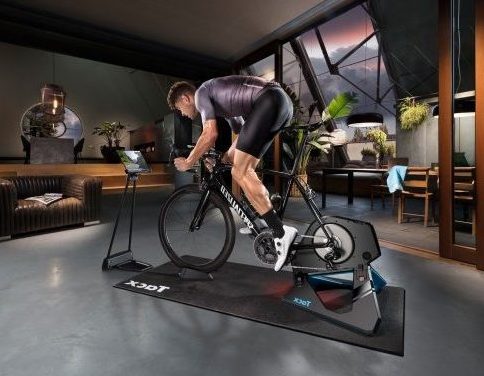
Let me help you out.
A smart trainer is a piece of equipment that you mount your bike on that offers resistance like a regular trainer.
However, a smart trainer’s resistance is controlled by cycling apps such as Zwift, TrainerRoad, FulGaz, etc.
Why Use a Smart Trainer?
Now, the next thing you might wonder is what is the hype around a smart trainer?
After all, it does function the same way a regular trainer does, but it costs more.
When you use a smart trainer during the off season, you get a more engaging and immersive indoor riding experience.
On a smart trainer, you are usually riding a virtual course. If you begin to climb a hill or go around a curve, you’ll feel a more real-life resistance or slow down and gear change.
And, when you go on virtual group rides or races, some trainer apps put on less resistance to simulate drafting.
To sum it up, a smart trainer makes indoor riding more fun and productive.
How a Smart Trainer Works
Smart Trainers use either an ANT+ or Bluetooth.
You need to load a smart trainer app on your phone, tablet, or computer since you can’t operate a smart trainer with a bike computer.
Then you connect the device to your smart trainer through Bluetooth or ANT +.
Nearly all smart trainers need to be plugged in so they can turn on and generate a workout for you.
It varies from model to model how the smart trainer generates resistance. And, many use a combination of using a flywheel (like a normal trainer), magnetic resistance, and an electronic motor/brake.
What’s Needed to Use a Smart Trainer
In addition to the smart trainer itself, you’ll also need a few other pieces.
- A computer, tablet, or smartphone with Bluetooth or an ANT + USB dongle;
- Decent WiFi;
- Your bike;
- A big fan.
Two Types of Smart Trainers
There are two types of smart trainers, generally: wheel-on designs and direct-drive models.
Wheel-on smart trainers look very similar to normal trainers. You clamp your bike on the rear axle and then tighten a drum to put resistance on your rear tire.
However, on a smart trainer, a wheel-on design is slightly lighter, cheaper, and easier to store since the legs often fold up.
However, every time you put the wheel on the trainer, you need to calibrate it. And, the power accuracy isn’t quite as good as a direct-drive model.
Direct-drive smart trainers are sturdy units that effectively replace your back wheel. The benefits of this design include accurate power measurement and no warm-up before calibrating. This nice equipment does come with a higher price tag.
Things to Consider
There are many factors to consider when you’re shopping around for a smart trainer. However, there are a handful of things that are applicable whether it’s a $100 or $1500 smart trainer.
Sturdiness
No matter what type of smart trainer you buy, it needs to be sturdy. The more plastic the trainer has, the less likely it will last for a long time.
Wahoo, KICKR, and Kinetic rate highly for being sturdy and long-lasting smart trainers.
Attachment Point on Your Bike
For the smart trainers, that leverage a skewer of some sort and don’t require taking off a tire, you should look for a trainer that has a “quick release” mechanism so you can quickly lock the trainer into place.
It’s a plus if that type of trainer also doesn’t require you to endlessly spin the tightening lever and try to find the exact spot every time you load your bike on the trainer.
For the trainers that require you to attach your bike directly into a cassette mounted on the trainer, be sure that it’s compatible with your bike frame! Many trainer companies supply this information on their websites.
Stable Platform
The next thing to look for in a trainer is its platform. It needs to be sturdy so it and you won’t tip over with it.
The smaller the base of the trainer, the more likely it will tip over.
Tip-overs happen occasionally and usually occur on a lower-end trainer.
This factor needs to be taken into account when the trainer mounts the wheel higher up and thus elevates your center of gravity. It’s easy to find yourself in a situation where you reach for your TV remote or something off to the side and then just fall off.
Direct Drive or Wheel-On
Remember, wheel-on trainers, let you mount your entire bike, including the back wheel. While the direct-drive trainers require you to remove your back tire and attach it to the trainer via a cassette on the trainer.
Modulated Resistance
With the information received from Zwift, smart trainers increase resistance when the course is uphill and decrease it when the course is downhill. They also decrease resistance when you are receiving a draft from a pack of riders you joined and increase resistance if you take the lead of a pack. Additionally, at least one model duplicates the feel of dirt or cobblestone roads.
Technical Considerations
Nearly all devices use ANT + or Bluetooth Smart to transmit and capture information such as heart rate, power, speed, cadence, and more while you’re biking.
For trainers, this means that it supports either broadcasting (one-way) from trainer to app/device you’re using. Or, it broadcasts dually on both the app/device you’re using and the trainer.
For a one-way broadcast, the ANT + or Bluetooth Smart Broad Cast can record power, speed, and cadence. On compatible devices such as triathlon watches, Garmin Edge, or Wahoo ELEMNT BOLT, they can also pick up and record these metrics. So, you can recreate your personal cycling excursions.
Nearly all trainers broadcast dually through either ANT + Fe-C or Bluetooth Smart FTMS. This means you can re-ride your outside routes with elevation changes and much more.
You should look for a smart trainer that is dual capable. This means it should support the resistance you want across a broad number of apps. And be sure to ask if the trainer supports either ANT + Fe-C or Bluetooth Smart FTMS. Since that affects what apps and devices it supports.
Range of Smart Trainers
Over the past few years, I’ve seen a major shift in price v feature-set combination. For example, features and capabilities that used to be reserved for a $1200 trainer have now slid down to $900 trainers.
The price brackets listed below, are aligned with 2022-2023 training pricing.
Budget Trainer (<$500): Budget trainers tend to have basic functions and features. And don’t have automated controls. Some have electronics and most apps support theses in a basic manner.
Mid-Range Trainer ($500-700): Mid-range trainers start to get more “fancy” compared to budget ones. On these, you’ll see electronic resistance control and full-app integration. Most of these trainers are wheel-on trainers except for one of the Zwift models.
Mid-High End Trainer ($700-1,000): These trainers are a step-up in every manner compared to a mid-range trainer. Everything moves more efficiently, more features, and has a better and easier initial set up.
High-End Trainer ($1,000 +): These are the top of the charts of trainers. They have better durability compared to the mid-high end trainers. And, they reduce noise while you’re riding, increase incline and wattage, and a lot of other features that makes it expensive.
Best Direct Drive Bike Trainers
1. Wahoo KICKR v6 2022
The Wahoo KICKR is the first of three Wahoo smart trainer’s I’ll review in this piece The Wahoo KICKR 2022 edition is 6th generation now of Wahoo’s kind of flagship indoor direct-drive smart bike trainer.
I’m sure you’ve heard of the Wahoo KICKR smart trainer, but does it live up to its hype?
Read on and you’ll be able to make a decision for yourself.
To start, let’s talk about the trainer’s compatibility.
Wahoo KICKR, no matter what specific model, offers one of the widest range of compatibility and connectivity. It is a very easy to use bike trainer, compatible with road, triathlon, mountain and gravel bikes, with wheel sizes from 24” to 29”.
You can sync your sports watch, heart rate monitor, or bike sensors from either your phone, tablet, or computer. You’ll rarely have to worry about a failed connection so you can just have a nice ride.
And, the smart trainer works with most training apps. This makes it easier for you since you won’t have to sign up for another account, remember another password, and sync that accounts to another training app you use. The trainer works with apps such as Zwift, TrainerRoad, The Sufferfest and more.
Like other smart trainers, this one is made to be nearly silent during your ride. Your house won’t shake while you ride and you won’t disturb your family members or roommates. The technology behind this trainer is designed so that you’ll only hear the sound of your chain as your shift gears.
This trainer also wants to give you as close to a real or outdoor ride feeling as possible. To do this, Wahoo has a large 16-pound flywheel for you to use. And, Wahoo’s new technology and algorithms actually improve responsiveness and better replicates the feeling of riding on the road instead of your basement. If you decide to do a programmed workout or doing a free-ride, you’ll be able to imagine yourself clearly on your favorite outdoor route.
Training for Age-Group Nationals, Worlds, or just want to improve your cycling?
You can get the most resistance on this very stable design trainer. This has over 2,200 watts of resistance so you can get the most intense workout you need.
This smart trainer comes as ready to ride as you are. It comes with pre-installed 11-speed cassette, RPM Cadence Sensor, convenient carrying handle and tire size height adjustment. This makes it easy for you to set up and be on the bike in no time.
Worried that the trainer won’t last long?
Don’t be! This trainer is made from steel and has a wide base so that it stays in place while you pump up the intensity during your workouts. It was built to withstand the demands of your training program.
Wahoo KICKR 2020 vs Wahoo KICKR 2018
If you’re familiar with the 2018 KICKR, it’s kind of hard to notice the differences in this device. But there are some key differences:
- Axis feet. These are just a little rubber feet items that kind of go on either side of your KICKR. It allows for some side to side motion and gives you up to five degrees of movement. Wahoo KICKR comes with three different sizes of these Axis feet and they’re designed to be switched out kind of based on your weight.
- On top of all of these features, you can be sure that this smart trainer will give you a reliable and accurate measurement system (+/- 1%). It really gives you a great riding experience whether doing a programmed or free-ride.
- Newest KICKR doesn’t require calibration anymore. Before now you had to do a spin down to calibrate the trainer before each ride, but that is no longer necessary.
Triathletes and cyclists who have bought the Wahoo KICKR have loved it because it comes just as advertised. There are few to no glitches in the technological side and it sets up easily. The drawback would be if your drive train, hub type, and wheel size weren’t compatible. But, if you look at Wahoo’s website, you’ll see that it is very inclusive to different bikes.
I recommend this trainer if you’re looking for an all-around, sturdy, and long-lasting one that you can depend on and help you achieve your cycling goals. It’s compatible with many training apps so you don’t need to set up a separate account with Zwift. And, the metrics are measured very accurately.
2. Tacx Neo 2T Smart Trainer
The new Tacx Neo 2T smart trainer has improved and resolved more internal features and technical issues than external. This might be good news depending on what problems you had with its previous model.
Tacx Neo 2T vs Neo 2
What does Tacx claim to be new and improved?
- Stillness — The new trainer has reduced the noise from vibrations.
- Ride feel — Stronger motor power for a more realistic ride feel during climbs and sprints.
- Axle Compatibility — The smart trainer is compatible with more axles than the previous model.
All these changes seem ok but how does the trainer feel once you start those grueling workouts on the trainer?
Setting up the smart trainer isn’t different than other Tacx trainers. You’ll need a lockring tool and a chain whip to just get the cassette onto the flywheel. But, after, the rest of the setup is fairly straight forward.
Also, to note, you don’t need to plug in the smart trainer to use it. The only feature you’ll miss is the downhill drive without the plug.
Like other Tacx trainers you have ERG and Simulation modes, which greatly differ. The Simulation mode will mimic an outdoor course while the ERG mode remains a specific power level you program.
While “riding” the bike, users have said that the trainer is very responsive to changes in grades and speeds. Some have even said it responds too quickly and it can feel like the bike is “moving” too fast.
The trainer is compatible with most of the training apps triathletes use such as Zwift, TrainerRoad, and others. The only drawback some have is the protocols and transmission standards. The trainer supports ANT+ and Bluetooth Smart, but not FTMS on the NEO series.
This small snag won’t affect major training apps but won’t work with smaller and less known apps.
Users have reported high accuracy for their power meters and are close (+/- 1%) to data they get from riding outdoor.
3. Saris H3 Smart Trainer
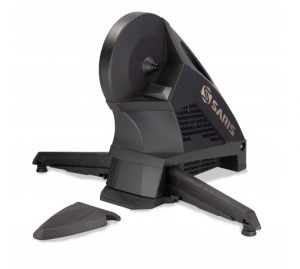
The Saris H3 smart trainer is quieter and more accurate than its previous models and even has a new drivetrain mechanism to reduce the noise. The company has also improved or resolved most of the firmware issues that user have complained about.
And lastly, the company has added internal cooling to keep the trainer from overheating.
A few but significant changes that might make a difference for you.
Like any smart trainer, to set with one up you need to install the cassette on the back of the trainer. Unfortunately, this trainer doesn’t supply you with one so you’ll need to have on handy or buy one. Please note the XD/XDR adapter is not compatible with 12-speed cassette.
After set up, just plug in the trainer and mount your bike.
Once on the bike, most users say that the trainer simulates the road very well. For those who have owned Wahoo and Tacx, users say the feel is close to Wahoo but better than Tacx.
When we talk about the noise level, most users say that the trainer is improved from the H2. But, it’s not silent in same way a Wahoo trainer is “silent”.
Like the Tacx smart trainer, this one has two modes ERG and Simulation modes, both which work the same way as described before.
The difference being that the Hammer 3 can simulate up to 20% incline, which is ok for the price you’re paying for the trainer. Some trainers at the same price can go up to 25%.
The ERG mode can simulate up to 2,000w of resistance, which is nice but not realistic even for professional cyclists and triathletes. These numbers don’t matter so much compared to the trainer’s responsiveness.
Users report that the responsiveness to shifting and grade changes is well programmed. No matter how drastically users shift gears, the trainer maintains the set wattage.
The smart trainers follows the industry’s norms when it comes to app compatibility and supports all major ones such as Zwift, Strava, TrainPeaks, and others like it. The trainer follows protocol transmission standards and supports ANT+ FEC, Bluetooth Smart, and Bluetooth Smart FTMS.
To take it a step further, the trainer transmits metric data within signals so you can pair your trainer to your computer or even Apple TV.
I’d recommend this smart trainer to anyone who is considering it. It adds value to its predecessors and is worth the upgrade money.
4. Wahoo KICKR Core
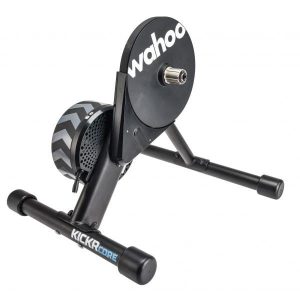
The Wahoo KICKR Core smart trainer uses everything featured with Wahoo KICKR and simplifies its design, which makes it an off-season tool you don’t want to train without.
The Core model, in the series of Wahoo smart trainers, was designed to give you a realistic, accurate, and quiet indoor riding experience. All of which is achieved with a fly wheel technology and backed with Wahoo’s advanced algorithms found on all their smart trainers.
To give you a realistic ride feeling, the KICKR fly wheel mimics the power and inertia you feel during an outdoor ride. This feature is especially proven if you use virtual riding and training programs such as Zwift or TrainerRoad.
Don’t be deterred by the smart trainer’s high price tag. If you’re ready to invest more time on your trainer, you’re better off with getting one that will last. And, this one will last. The KICKR Core was made to withstand the most intense workout you decide to do-watt for watt.
The stand is made of steel so you can be sure it will stay robust until you absolutely need to buy a different trainer. You won’t have to worry about the stand wobbling while you crank out the watts.
Trying to conquer the hills in your next race?
If you pair your KICKR Core with KICKR Climb, you can integrate real-life ascents and descents into your workouts. Since the maximum grade goes up to 16%, you can be sure you’ll be prepared any hill you may face in an outdoor ride or in a race.
Wahoo is notorious for being compatible with the most apps and third-party apps and this trainer doesn’t fall short of it. This trainer pairs with training apps such as Zwift, TrainerRoad, Strava, and a handful more.
Once you sync your device, the trainer will automatically set your resistance through your preferred app or software.
Of course, if you already have any KICKR trainer accessories, Wahoo ELEMENT Bike computers, or Wahoo Sensors, it syncs seamlessly with your trainer.
Don’t have those sensors, no need to buy new ones. Third party power meters and other sensors are compatible.
Once you’re done with your workout, your metrics will be safely and accurately stored on whatever training app you use. In fact, the accuracy is +/- 2%.
Triathletes who have bought the trainer, like it because it is a high-end trainer without extraneous “bells and whistles”. It’s quiet so even if the ones who train on the top floor of their apartment buildings can work out without disturbing everyone else. Some triathletes like that the resistance is so realistic that they can comfortably get into a standing climb. Other triathletes like it for its easy set-up, assuming you know how to pull a cassette.
I’d recommend this smart trainer to anyone who wants to kick their training up several notches and want a “realistic” way to practice climbing hills. If you have wheels that are smaller than 700c, it’s an easy fix. Simply use a wheel block in the front. Be sure you have a cassette and know how to change one if you do end up purchasing this smart trainer.
5. Elite DRIVO 2 Interactive Trainer
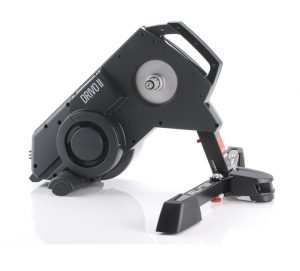
The Elite Drivo 2 smart trainer catches your attention first with its color and then with its technology will make you look twice.
The smart trainer’s black color gives it a sporty and aggressive vibe, which is what you need to fight off the off-season and winter blues.
And the most innovative piece of equipment is the internal power meter, which makes this trainer one of the most accurate in the market.
The integrated power meter determines watts with the same accuracy as a highly developed power meter. The accuracy is backed by the Optical Torque Sensor (OTS), which measures your power output within +/- 0.5% accuracy.
The smart trainer measures your power throughout your entire pedaling movement through a 24 points system. This makes it easier for you to analyze and improve your pedaling stroke. You can pinpoint which part of the pedal stroke is the least efficient and figure out how to work on it.
The pedal analysis uses two types of charts to display the power output change while pedaling, the overall coordination of the pedaling movement from using extensor and flexor muscles, and pedal roundness and mechanical efficiency.
One of the benefits of this internal technology is the timing of it. There aren’t any gaps between your pedal cycle and what the device shows. It’s all in real time.
Compared to the predecessor, this smart trainer is faster and more responsive to changes in resistance, inclines, and gear shifting.
The trainer’s stepping motor can adjust the needed resistance almost immediately, which give you a more outdoorsy feel to your ride.
You can connect your Zwift account or use Elite Real video and the trainer will adjust to whatever workout you throw at it.
Now, that I’ve mentioned Zwift, let’s talk about the trainer’s interactive technology.
This trainer is ANT + FE-C and Bluetooth interactive that is compatible with most, if not all, apps, software, computers, and devices (smartphones and tablets) that support iOS, Android, MacOS, and Windows.
Once you set up the trainer, all you need to do is set your course through your preferred device and program. The trainer will then automatically adjust resistance and manage your workout session.
The trainer also supports indoor cycling services such as My E-Training software and others that require a subscription.
Small details to mention is the slope simulation. This trainer can accurately and powerfully simulate slopes up to 24%. It’s possible since this trainer has a high power output even at a low speed.
The trainer has an internal 6 kg fly wheel, which recreates the same pedaling roundness that you feel on the road.
All this technology sounds like would make a lot of noise, but this one is very quiet. All you’ll hear is the bike chain and you.
Triathletes who have bought this trainer like it because it is responsive and realistic. Some report that it’s almost so realistic to cycling on the road it’s scary. They can program any structured workout or outdoor ride and the trainer accurately simulates every incline and downhill. Triathletes say it helped them improve their times on routes they normally ride outside. To top it off, they really like that the trainer is quiet and won’t disturb anyone else in their homes.
I highly recommend this to anyone who considers themselves a serious cyclist and triathlete. This one is highly innovative and has the most accurate readings because it has an internal power meter. And, it’s one of the few trainers that can simulate inclines in the 20% range.
6. Elite Direto XR
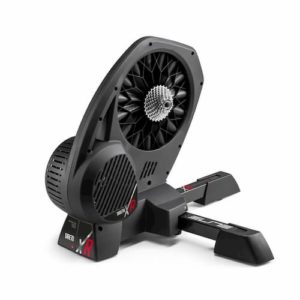
The Elite Direto XR smart trainer has upgraded its parts and features to make it competitive with other mid to upper range trainers such as Wahoo and Tacx.
Elite Direto XR vs Direto X
So, what has changed?
The trainer can now mimic up to 24% incline from 18%, remained the same its accuracy of the power meter to +/- 1.5%, upped flywheel from 9.2lbs/4.2kg to 11.2lbs/5.1kg, and now quieter. These may seem like minor changes but they do make a difference in ride and training quality. Also, cassette now included (11-speed Shimano/SRAM compatible).
When it comes to the “real” riding feeling it all comes down to the flywheel. While this trainer is trying to compete with others such as Tacx Neo, Saris H3 or Wahoo KICKR it doesn’t quite match up, but those are all more expensive bike trainers. Other companies such as Wahoo make larger flywheels with better inertia.
Of course, design wise, there aren’t any flaws with the Direto XR’s flywheel, it’s just not up to a high-end trainer standard. This makes the “real” road feel less realistic and can be a “turn off” for some. Be sure you get to test out the trainer before buying it. Some users are happy with the flywheel while others want something more realistic.
And, the trainer like the others reviewed have ERG and Simulation mode that work that same way as other trainers. These modes change the resistance automatically. What you look for here is how responsive these modes are to changes in gearing.
Users report that this smart trainer does respond quickly but it’s not always smooth when there are big shifts. This would be things such as shifting from the small to the large chainring.
This “flaw” bothers most users since they like to have their bikes respond smoothly to gear changes. And, this isn’t always possible on this smart trainer. Some even report the trainer shaking a little after big changes.
If you’re worried about app compatibility, no worries, the trainer supports all major apps, which makes it easy to use. And, supports ANT+ FEC and Bluetooth Smart so you can program specific apps and simulate courses and set wattage goals.
For power accuracy, this one is nearly flawless. There are few bugs to work out and the data the meter gives matches what your power meter would give you.
The Direto XR is compatible with 9-, 10-, 11-speed Shimano, SRAM, Campagnolo, etc. cassettes. So it’s all good to go if you don’t need that one that comes fitted in the box.
I’d recommend this trainer to anyone who needs a mid-range one and doesn’t want to break the bank. The only drawback is the flywheel which makes the bike feel less real.
7. Elite Suito

After reading through many trainer reviews, this might all seem the same. And, in reality there is some truth to that statement. Most trainers are very comparable when you look at technologies, capabilities, and features.
Now, it comes down to whether the trainer gives you the most for the price you pay.
Will this bike trainer give you the most for your money?
Read on and you can decide for yourself.
This trainer is interactive and wants to give you a realistic riding experience with accurate metric data. It comes with its own 11-speed cassette, which saves you time and some money.
Once out of the box, the trainer is pre-assembled. Just put the bike on the trainer and plug it in. And that’s it! You’re ready to start winter training.
Some users have noticed that the chain is loud after set up, but after lubing up the chain, the noise went away.
Last accessory to note is the 3.5 kg fly wheel. Compared to the Wahoo KICKR Core it’s about 2 kg less and about 3kg less than the Tacx smart trainers.
Remember, a flywheel is the magic that makes a bike trainer feel real. If you’ve bought a Wahoo or Tacx trainer before, this might not be your best choice. Otherwise, this trainer might be worth looking into.
Having said that, even with a smaller fly wheel, Elite created a secondary belt to mimic the fly wheel effect. So, on the bike it feels very similar to the Elite Direto smart trainer in terms of feeling “real”.
The smart trainer is compatible with ANT+ FEC and Bluetooth Smart so you can use whatever training apps and device you use when you ride outside.
On the bike, users report that the bike does averagely well. It’s good for the money but it’s not the same as training on a Wahoo trainer.
Users report that the power data accuracy is slightly off compared to other products, but most were happy with the results.
I’d recommend this smart trainer if you’re looking for one that won’t break the bank, but will give you a lot of value for your money. In a few years, you might want to upgrade.
8. Tacx Flux 2

The Flux 2 comes with bigger and stronger resistance unit and a heavier flywheel compared to its predecessor. All these new upgrades give you a wider simulation range, better ride feel, and finally a more accurate measurement.
One of the features that make this trainer different from others is its fly wheel. For those who don’t know, a fly wheel makes riding on a trainer as realistic as possible. Just like when you stop pedaling, your bike does not stop rolling immediately, the fly wheel simulates this kinetic energy. The heavier the wheel, the more realistic the feeling.
All Tacx trainers come with either an actual or virtual fly wheel. For you to get the best experience with the wheel, you need to simulate your exact weight on the wheel. This is accomplished the most accurately with a virtual fly wheel.
A virtual fly wheel can adjust the inertia to factors such as speed, slope, and weight, which makes it very close to riding outside.
This Tacx smart trainer comes with an actual fly wheel and it’s a large wheel that weighs around 7.6 kg to ensure you feel like you’re riding on a road or very close to it.
If you’re feeling up to a challenge, you can do an intense hill workout almost to what you’d experience outside. This trainer can simulate inclines up to 16% gradient and make it feel realistic.
Want to sprint?
This trainer can help you achieve a stronger sprint for the outdoor riding season and your race season. This trainer is stronger than its predecessor and can put on a maximum sprint resistance of 2000 watts.
Need to record your trainer ride data?
No problem.
The smart trainer measures your power accurately within 2.5%. You’ll be able to see and analyze reliable, accurate and consistent power measurements. This will make it easier for you to track your progress and have more productive workouts.
If you need to store your ride data, the smart trainer does connect and support popular training apps such as Zwift, Strava, and Tacx. Of course, after your workout, you can post your ride data to social media if you wish.
Like other Tacx trainers, this one is also made to be silent or produce minimum noise. It tries to reduce vibrations and other noise produced by the trainer.
The electronic components of this trainer let you train stand, alone without any software. It follows a progressive power curve and the resistance will increase as you ride faster. Very similar to a liquid trainer and simulates riding on a flat road.
If you’re unsure whether the smart trainer is connected via ANT + or Bluetooth, the LED lights will give you a visual confirmation.
The price tag might be steep, but you’re paying for a highly technical and powerful trainer that will last a long time. The frame itself is designed to bear the most intense training sessions you can think of. And, the large footprint ensures maximum stability along with its durable materials.
Triathletes and cyclists who have bought the trainer like it because it is durable, easy to set up and use. The trainer gives them very accurate results so that they can change their workout regime as they need to. Unlike the previously reviewed Tacx trainer, this one works better with training apps and using the Tacx app isn’t such a large part of the riding experience.
The fly wheel is a big plus for some triathletes. They don’t have to buy a different tire for the trainer and it helps simulate riding outdoors. On the other hand, some people think it’s annoying to change wheels every time they take the bike on and off the trainer.
I’d recommend this trainer to those who want one similar to the previously reviewed one, but this fewer features and better connectivity and app options.
9. Kinetic R1
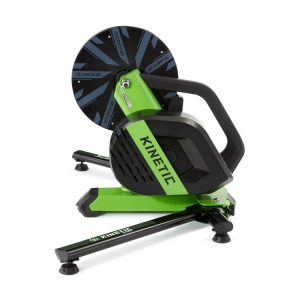
The Kinetic R1 smart trainer uses both interactive and direct drive technologies, which makes this one ahead of its class of high-end trainers.
The top features mentioned above, help the bike move more naturally on the trainer, make you feel more comfortable on the bike, and it feels more realistic.
Additionally, you get a complete workout with this app-controlled trainer, which submerges you and other riders into a world of virtual training. This makes training on the trainer more enjoyable and interactive. Perhaps, even more, than you have felt in the past.
This trainer is compatible with nearly all bikes so if you’re training for off-road triathlons, it’s possible in the winter months. And, if your bike has a rear thru-axle, you’ll still be able to use the trainer.
The maximum slope is 20% and the maximum resistance is 2000 watts. And, the accuracy is +/- 3%. The trainer is compatible with 130 and 135 qr, 142 and 148 (Boost) tru axles. And, supports 9-11 speed Shimano/SRAM drive trains.
Now, that I’ve given you a brief overview, here are several details worth mentioning:
- Connects to popular training apps such as Strava and Zwift through ANT +, ANT + FE-C, and Bluetooth FTMS.
- Connects to PCs through the USB port for reliable internet connection. The USB port allows for top-notch performance in training apps that require the best connectivity (such as group riding scenarios).
- Rock and Roll technology that makes this trainer the only direct-drive trainer free of movement. This means you don’t need a rocker plate.
- The trainer has an interactive electronic distance that controls your effort on the bike. Additionally, it has controlled resistance to mimic terrain changes in workouts if you’re on a virtual course.
- Massive fly wheel to help give you a realistic ride feeling.
- Ergonomic rubberized knobs and feet so it won’t damage your floors or mat you put your trainer on. And, it has folding legs and a comfortable handle so you can easily carry and store it away when you need to.
Tool-free hub body swap so you can easily change between bikes. However, an additional hub kit is required and can be included when you purchase. - Side-to-side frame movement for comfort and an ab workout. It also mimics how you’d move your bike from side-to-side when you’re on the road.
Triathletes who have bought the smart trainer like it because it is very realistic to moving a bike on the road. Especially with the side-to-side motion. It’s a really unique feature and really helps the triathletes who want to improve their speed and some handling skills on the bike. The flywheel is ideal and is a good option for some.
Other features triathletes like are little but make a big difference. Some include the ease of setting up, transporting, and moving it.
This trainer has nearly everything you would need and more. The big feature is the side-to-side movement that really gives you the feeling of riding on the road. It’s one thing to sit on your bike trainer and it’s another to be able to move your bike like you’re on the road.
The accuracy might not be as low as other trainers mentioned, but it comes with many other great features. And, it’s been reported if you update the firmware it becomes more precise.
Best Wheel-On Indoor Bike Trainers
1. Saris CycleOps M2
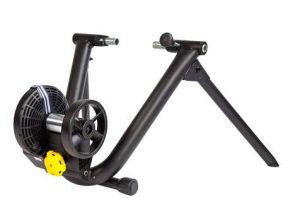
The Saris (CycleOps ) M2 is the 2019 update of the popular CycleOps Magnus wheel-on smart turbo trainer.
The Saris M2 allows you to ride with a virtual group on Zwift, climb hills on your preferred app, or just a sweat free-ride session. Whatever workout you need, the smart trainer can support it.
The bike is low-maintenance and is easy to set-up. All you need is your bike, the trainer, your preferred training app, and your device (smartphone, tablet, bike computer, etc.)
The trainer has the capacity to handle up to 1500 watts at 20 mph at 15% climbing grade. It’s ideal if you’ve been in the sport for a few years and want to kick up your biking strength for next season.
Once your bike is connected to the trainer, all you need to do is connect your virtual training software (Strava, Zwift, Training Peaks) through dual-band Bluetooth Smart or ANT + FE-C. From there, the trainer’s electromagnetic response system takes care of everything else. This part makes it a “smart” trainer instead of a “regular” one.
You can either do a structured workout through your training app, a free ride, or re-ride a route from outside. The trainer will respond well and put on the needed resistance.
You won’t need to buy or use extra sensors for your Saris trainer, this one has integrated cadence, speed, and power data that be viewed in real time. This will make it easy for you to know if you’re hitting your target number and precisely how much more you need to work.
On to the trainer’s accuracy.
Compared to the other Saris trainer reviewed, this one is less accurate, but not by much. This one has +/- 5% power readings. This shouldn’t be a deal breaker since 5% is such a small number to be off by. Keep in mind, your other devices such as your sports watch and bike computer are not always accurate. So, I wouldn’t be quick to dismiss this trainer.
Triathletes who have bought this bike trainer like it because it’s a reliable, sturdy trainer that has a good reputation among the triathlon community. The set-up is so easy. All you need to do is replace your bike’s skewer with the trainer’s, which has steel connectors that fit into the bolt action tubes on either side of the trainer. Triathletes like it because they got a bundled deal when they purchased the trainer. It also comes with cadence, speed, and power detectors. So, they didn’t need to buy new or extra ones. On top of it all, the trainer is quiet.
I’d recommend this trainer to those who don’t want a fancy trainer, but just one that can connect to training apps as if you’re riding outside. It’s sturdy and you can get through years of indoor training before you decide to upgrade it or sell or a different one.
2. Wahoo KICKR Snap

This is the third and last Wahoo Smart Trainer I’ll review for this piece. And, just by looking at it, it’s one of the simpler looking ones.
For starters, this one does use a fly wheel, which makes the set up easier if you don’t know how to change a cassette. You attach the bike to the trainer as if it were a “regular trainer”. It makes it more convenient for you no matter if you ride a mountain, road, or time trail bike. You’ll be set up and ready to go in minutes.
What makes this a smart trainer is the technology and Wahoo algorithms that back it up.
This smart trainer doesn’t run on a computer. Instead, it connects to your smartphone, GPS device, or bike computer. Once the two are synced, the bike trainer uses your selected device to control the resistance and provide reliable power measurements (+/- 3%). It’s easy for you to adjust and monitor your metrics since it’s set-up just like it would be during an outdoor ride.
The trainer is compatible with iOS, Android, and PC (Windows and Mac).
Since the trainer connects to your device, it supports any training app you regularly use. This simplifies your set up and you won’t need to sign up for another account or sync two accounts.
Like other Wahoo KICKR trainers, this one also is durable and stable. The stand is made of carbon steel so it’s long lasting and light-weight. You can rely on it and you won’t fall off the trainer, no matter how intense your workout is that day.
Some differences worth mentioning, are the gradients and realistic ride feel. While there are some resistance and hill gradients, it won’t have the same quality as a more expensive Wahoo trainer. You’ll be able to get stronger, no doubt, but it won’t feel as realistic since it’s not as streamlined as other models.
For some nitty gritty details, this trainer is compatible with most, but not all wheel and hub sizes. And, since this trainer is simpler compared to the other two reviewed, it weighs more and is not as small. It’s not unbearable heavy or big; just something to be aware of.
If you’re unsure if your smart trainer and device are synced, there are LED lights on the side of the trainer. Like the other trainers, when the LED lights are illuminated, you’ll know that your SNAP is powered, connected, and transmitting signals to your device.
Triathletes who have bought the smart trainer like it because it is easy to set up and use. Just take it out of the box, attach your bike, sync your device, and you’re ready to go. Triathletes love the structured workouts and it’s a set up from a liquid trainer and almost feels like riding on the road.
I’d recommend this to anyone who wants a smart trainer without all the extra bells and whistles. You can still get structured workouts, free rides, and connect your power meters, but with a lower cost. If this is the type of trainer you know you’ll use for several years, I’d suggest purchasing it. If you know you’re going to want something with more features in the coming years, definitely save up for that type of trainer. Or, buy a liquid trainer.
3. 4iiii Fiiiight

The 4iiii has brought the smart trainer to a new planet with its newest model.
The Fiiiight is the most silent trainer and has “Zero Contact” technology. The only noise you’ll hear is your chain and your gears shifting.
“Zero Contact” technology means that you won’t have to worry about trainer tires or wearing out your current one. If there is an occasional nice winter day, you can easily take your bike off the trainer and ride outdoors.
If you travel for work, you can easily take your bike and trainer with you. The trainer folds flat so you can pack or store it anywhere. Additionally, the trainer has at least 2 hours of batter life so you can train if there is a power outage.
How does the trainer work without touching your wheel?
The back of the trainer has two sensors and it detects where your wheel is and adjusts accordingly. And, there is an optical sensor on the little poles close to your rear wheel. Theses sensors measure your acceleration and adjust for real-time resistance.
Here are a few key features and specs to run through before going on:
- 7% incline simulation
- +/- 1% accuracy
- ANT+ FEC and Bluetooth Smart FTMS for trainer control and power and cadence transmission
- Metal wheel required
How does all this technology feel once it’s put into play?
Users say that the ride feel is “ok” and it’s not bad but it’s also not “not out of the ballpark”. Other smart trainers at this price point will have a better feel.
What’s the main appeal of the trainer?
The silence.
You won’t hear anything except your bike’s gears and chain and no floor vibrations.
The bike is still in the beginning works for technology and will be updated in the coming weeks after this article will be published. I’d check back then and see what updates are on the company’s website.
The most innovative technology on the trainer is the automatic alignment for your rear wheel and measure your acceleration in real time.
I’d recommend this trainer in the weeks to come. I’d wait to buy the trainer until they have fixed all their small issues and given the trainer a more real feeling when riding it.
4. Elite TUO

The Elite Tuo, when compared to the previously reviewed Elite trainer, is simpler and can still help you become a stronger cyclist.
In short, this trainer is an interactive wireless trainer with an automatic resistance adjustment. And, has double ANT + FE-C and Bluetooth communication that interacts well with most, if not all, app, software, computer, smartphone, and tablet.
This trainer is very easy to use and is set-up as if it was a regular trainer. It’s a great option for beginners and even seasoned cyclists.
After the set up, you can cycle any type of workout from a free-ride to climbing to high-intensity speedy sprints.
Since the trainer has an electronically managed magnetic resistance, it can bear a high number of workouts, a wide range of power levels. And, can simulate slopes up to 10% since the trainer can bear 1250 watts at 25 mph(40km/h) or 2,050 watts at 37mph (60km/h).
The trainer looks like a lower-end one, but not to worry, it was built with stability. The trainer was designed with Fast Fixing Locking System so the bike stays in place. To lock the bike onto the trainer, all you need to do is lower the lever and it stays put. It’s easy so when you’re ready to take it off, it won’t take too much time.
There hasn’t been any safety issue reported since the trainer has a reinforced frame and has a wide contact surface. All of these factors make this trainer a great option for a home trainer.
This trainer is quieter compared to other mid-range smart trainers. The wheel rests on a red roller made of Elastol, which is the exclusive polyurethane compound developed and tested by pro triathletes.
This material decreases the noise coming from the roller and tire friction by nearly 50% and tire consumption by 20%.
Additionally, the roller is wider than traditional rollers and other trainers, which gives it advantages such as:
- Wider contact surface between the tire and the roller
- Fewer slippages
- More power transfers between the tire and roller
- Decreases the roller rpm
- Less noise produced
A lot of what was discussed makes this trainer seem like a regular one.
So, what makes it a smart trainer?
The trainer interacts with any kind of apps, software, computers, and devices across any type of operating system.
For this trainer, the data transfer between it and other areas of the system is wireless. This makes it easy to manage resistance levels and display all different metrics on your chosen device.
It’s also ANT + and Bluetooth compatible, for those who are curious.
Similar to the other Elite smart trainer, this one can display accurate results for speed, and power data. And, all Elite trainers rely on real-time transmission of power and speed so you can hit your target numbers and conquer different workouts. All of this is done without sensors.
Cyclists who have bought this trainer like it because it’s simple to set up and use. It’s a step up from a regular trainer and gives more efficient and accurate results. Athletes really like the pedal analysis and they believe it helped them once the race season and outdoor riding started.
I recommend this trainer to those who need something a little more “smart” than a “regular” trainer, but don’t want to spend a fortune on one that has a lot of features. It has the interactive features of a high-end Elite smart trainer, but the simplicity and price of a low-end smart trainer. This would be a good option if this is your first smart trainer or know you won’t want a fancier one down the line.
5. Kinetic Road Machine Control

The Kinetic Road Machine Control smart trainer is one of the many from the Kinetic line-up of trainers available. This one combines the top-of-class frame with the latest interactive resistance technology for the best computability with apps and devices.
All you need to get started is your bike, trainer, fly wheel, and a skewer. Once you have all the parts, just mount the resistance unit, replace your bike’s skewer with Kinetic’s quick-release skewer and finally mount your bike.
Nearly all bikes will work with this trainer, but if your bike uses a 12mm thru axle, it’s highly recommended to use a Kinetic Traxle tru-axle adapter. This will prevent the training from damaging your bike. If your bike has internally geared hubs, tru-axles not, 12mm, or even wheels as small as 16 inches, you’ll be able to mount your bike.
Another feature worth mentioning is the 12-pound fly wheel that provides the highest inertia compared to other trainers in this class. It does a decent job of mimicking the feeling of spinning up, coasting, and descending.
How much resistance you put on the bike is electronically controlled through interactive training apps such as Zwift. These apps control how difficult or easy your ride effort feels depending on what workout you choose for the day. Virtual courses can mimic mountain climbs and descents with amazing accuracy so you’ll be prepared in the spring time.
Where can you find virtual workouts?
This trainer supports a number of training apps that offer virtual courses or even mimic routes you do outside. Apps such as Zwift, Kinetic Fit, TrainerRoad, Kinomap, The SufferFest, and FulGaz are just a few ones that I’ll name.
All you need to use these apps is either a smartphone, computer, or tablet and a communication protocol (ANT +, ANT + FEC, Bluetooth FTMS). If you have a Garmin product, you can also use that just as easily as one of the devices mentioned above.
Compared to the previously reviewed Kinetic smart trainer, this one is significantly less innovative. However, it has all the features that make it a smart trainer backed with the reputable Kinetic brand. You can control resistance from your preferred device to maximum slope grade of 10% and maximum resistance 1800 watt at 30 mph. But you can’t move from side-to-side on this one.
Triathletes who have bought the trainer like it because it costs less than the Kinetic R1 trainer, but has nearly all the same features minus the side-to-side movement. Those who consider themselves intermediate to entry-level advanced triathletes have bought it and have kept it for years. All say that it’s easy to set-up and have has little to no problems connecting the trainer to a smartphone or other devices.
I’d recommend this smart trainer to those who want a reputable one that won’t break the bank and can be one that you can “grow” with as a triathlete. Some of the features you might not need right away, but as you become seasoned in the sport, you’ll be glad you bought a nicer trainer, to begin with.
Any issues you might have with connectivity are often due to the firmware. Try updating it or checking Kinetic’s website for updates. Few triathletes have reported major issues that resulted in returning the trainer.
Again, there’s nothing wrong with purchasing a smart trainer that doesn’t have all of the latest features. Just get one that works for your training needs.
6. Kinetic Rock and Roll Smart Trainer 2
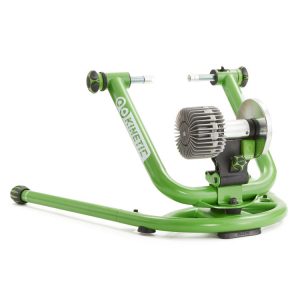
The Kinetic Rock and Roll Smart Trainer 2 combines the features of a free-moving fluid trainer with intuitive and interactive app-based power training. The result is a more realistic experience and cycling-specific workout compared to your current fluid trainer (if you have one).
The trainer is pre-installed with inRide 3 power sensor technology which allows riders to connect to a world of training workout, virtual rides, and even riding outside routes. All of this is done through training apps such as Kinetic Fit, Zwift, TrainerRoad, Rouvy, KinoMap, etc. No additional add-ons are needed for this smart trainer.
The new ANT + connectivity technology allows your training data to be broadcast on your bike computer directly using communication protocols such as Garmin devices or training apps that support ANT + dongles on desktop computers.
This smart trainer works a little different compared to the other trainers reviewed. Remember, a fluid trainer increases or decreases resistance with wheel speed. So, you must shift gears and speed up and slow down to vary resistance. When you connect training apps to the trainer it gives you power targets to match by varying speed and gears. Very similar to riding on the road.
This one is a tire-driven trainer so it’s highly recommended to use a trainer tire. Yes, the trainer has a large diameter roller designed to reduce tire wear, but if you’re on the trainer for hours each day, then just change it.
As mentioned before, this trainer connects to apps through dual-communication. It uses ANT +, ANT + FEC, and Bluetooth FTMS on connected smart phones, tablets, and laptops. And, if you have a Garmin device, this trainer can connect to it as well.
In terms of compatibility, this trainer rates very high. Most bikes can be mounted on this Kinetic tire-drive trainer. It even includes bikes with thru-axles, internally- geared hubs, and wheels as small as 16 inches.
Triathletes who have bought the trainer like it because it combines features of a fluid trainer (a familiar and popular “regular” trainer) with a smart trainer. It’s easy to set up and use and it doesn’t have extraneous “bells and whistles” of higher-end smart trainers. And, it mounts all types of bikes and even has a small wheel adapter if needed.
I recommend this trainer to anyone who wants a “simple” smart trainer that is not too much different than a regular trainer. It doesn’t have “fancy” equipment, but it does make you work to reach target metrics to simulate an outdoor ride or a pre-planned workout.
7. Kinetic Road Machine 2
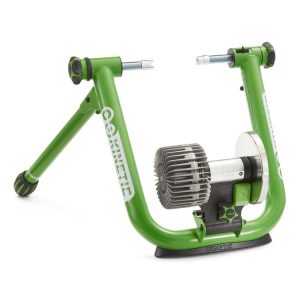
Accurate, affordable and easy to use are just a few adjectives to use to describe the Kinetic Road Machine 2. This trainer combines the intuitive app-based power and focused training features with the “landmark” fluid trainer.
The Kinetic Road Machine 2 “communicate” your training metrics to apps on your smartphone, tablet, laptop, and bike computer. No need to buy additional sensors or add-ons are necessary.
This works very similarly to the previously reviewed trainer. You control the fluid trainer resistance by speeding up or slowing down instead of the app controlling it. You can see on your chosen device if you’re hitting the target numbers to mimic an outdoor route or a preplanned workout from a training app.
Like other Kinetic smart trainers, this one also uses the most up-to-date communication protocols: ANT +, ANT + FE-C, and Bluetooth FTMS on a connected smartphone, tablets, and laptops. It can even connect to your Garmin devices if you use them as well.
Different from the previous trainer reviewed, this one has a 6.2 lb. fly wheel, which helps make your indoor ride feel more realistic. But, you know that there are heavier fly wheels available for different trainers. It depends on what your training needs are. Perhaps, a 6.2 lb. fly wheel is perfect for your first smart trainer.
Triathletes who have bought it because it’s simple design gives them powerful and significant results. Without the extra bells and whistles, this trainer has fewer technology “melt downs” so they can spend more time training. And less time trying to make technology work. Sometimes, it’s more fun to ride without the hassle of technology. Some triathletes have had problems with the Kinetic sensors. They claim that the sensors give inconsistent or slightly inaccurate feedback when compared to Garmin products.
I recommend this trainer to anyone who wants a less expensive version of the Kinetic Rock and Roll 2 but will the same technology as it. Yes, it does have a lighter fly wheel than the other trainer, but that shouldn’t be a huge turn off from using it. You can still train hard and get stronger on the bike with it. As for the sensors being inconsistent, if it doesn’t work well for you and you have Garmin accessories just use those.
Using Smart Trainers FAQ
Smart or Dumb Trainer?
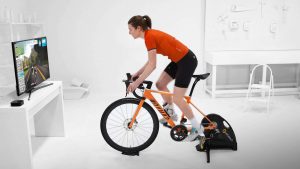
Dumb indoor turbo trainers cannot use Zwift or communicate with your electronic devices. So, they cannot receive changes in resistance that coordinate with the virtual course you are viewing. They also cannot record and transmit your power and cadence readings.
Smart trainers can be controlled by Zwift to increase your resistance in relation to the virtual course you are viewing. They can also transmit changes in your power and cadence. Zwift can use that information to change your position on the virtual course you are viewing. This can add to the fun of your training, especially if you are racing against other riders. Overall, smart bike trainers add an element of fun to your workout.
Wheel-on or Direct Drive Smart Trainers?
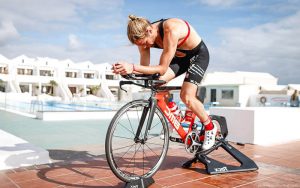
Smart trainers connect to your bike in one of two ways, either wheel-on or direct drive. With the less expensive wheel-on versions, you attach the smart trainer at the rear axle with the rear wheel of your bike intact. For direct drive trainers, you need to remove the rear wheel of your bike, install a cassette on the trainer, and then, attach your bike.
Wheel-on smart trainers are lighter and easier to set up than direct drive versions, but it takes a longer warm-up time to calibrate them. In addition, the power measurement is not as accurate as it is with direct drive versions Wheel-on smart trainers also can be folded compactly for storage or travel.
Direct drive versions require less warm-up time to calibrate and are more accurate in measuring the level of power you are generating than the wheel-on versions. They are also quieter and provide pop-out legs.
You can get more accurate stats, and stats more consistent with your outdoor cycling, by connecting a power meter to Zwift and then to your smart trainer.
Just be sure that whatever smart trainer you choose, that the base is broad enough and sturdy enough to prevent your bike from tipping over with you when you are peddling hard.
Do I need to use a trainer tire?
This question is personal preference and there are pros and cons to using your road tire on your trainer.
If you use the trainer a couple of times a week, then it’s probably ok to use the same tire.
However, if you ride a few days a week or more, then I’d recommend switching out your tires. Using your nice or racing tires on a trainer flattens them out and they become less useful on the road.
Do Trainer Tires Make Less Noise?
Nope.
Use last season’s tire and then toss it at the end of your indoor training season.
What Do I Put Under the Trainer?
You can buy a pad/mat that is specifically designed for a bike trainer.
However, you can use a towel or an old rug that you don’t mind using for your trainer.
Just be sure, that if you’re on a carpet that you change your towel regularly. Otherwise, you’ll see a stain develop over time.
Don’t overspend on this item. It is important, but as long as it’s sweat proof and offers some passing to lower the sound and vibrations any towel or rug will do.
Do I Need a Protective Pouch?
It’s really overkill if you put a protective pouch on your bike. It can hold your smart phone and protect your bike from sweat.
But if you wipe down your bike after each ride, you’ll be fine without one.
And, when you ride outside, you’ll be sweating all over your bike anyway.
Conclusion
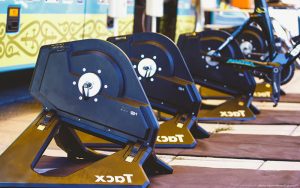
Your indoor training can be enhanced with a smart trainer. Information about your power and cadence can be transmitted to your computer or smartphone. Your cycling power and cadence will be varied by the resistance changes that relate to the virtual course you are viewing. You will be adding fun and can also add some social camaraderie to your indoor workout, making it more enjoyable and less tedious. So, you are more likely to keep to your workout schedule with a smart trainer.
I hope this article helped you narrow down your search or even make it easier to navigate through the high number of options. There are always new products coming and ones that have the most innovative technology. But they essentially all do the same thing: help keep your legs strong in the winter and even help you become stronger on the bike.
It depends on your training needs and if you need a high-end trainer or a low-end one with some features, but not too many to cause technology “melt downs”.
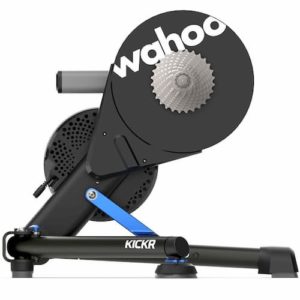
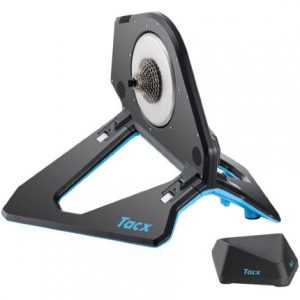
The Neo can’t be calibrated because it doesn’t need to be. It is always accurate from the start. The slight difference in wattage is due to the fact that there is chain resistance that isn’t accounted for at the point in which wattage is measured on the Neo.
What is your feedback regarding bike trainer apps and platforms? ZWIFT, Sufferfest, TrainerRoad, etc.
Zwift if you like the game element and races and building up a character unlocking bikes and jerseys and stuff.
TrainerRoad is great for watching TV whilst you ride, nice minimised interface that sits on top of media players.
The Sufferfest is a complete training system. Ride/Run/Swim, Yoga, Strength, Nutrition, Mental toughness. Custom plans if required.
I want to buy the NEO 2T and my question is: do I need to buy a ANT+ stick to get my HRM on Zwift? I have a Macbook and Garmin chest band (the latest, no bluetooth).
You will need an ANT+ Dongle so that Mac Book can recieve data from the Heart Rate monitor.
I learned alot of this when I first got a smart trainer. I made a Youtube video about the other stuff I had to buy after I got the smart trainer. Here is the link to it.
https://youtu.be/-3KSS9yNqlk
Hi Andrew,
You can use ANT+ with an ANT+ USB dongle. At least you don’t have to buy new sensors.
I have a Youtube video I made about my experience buying a Smart Trainer and the other stuff I needed to get.
Check it out
https://youtu.be/-3KSS9yNqlk